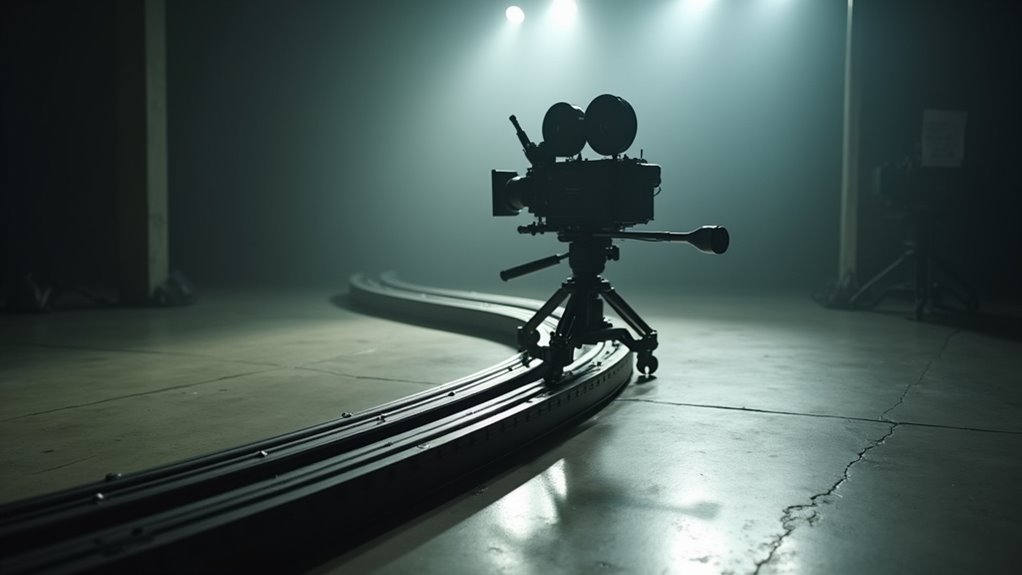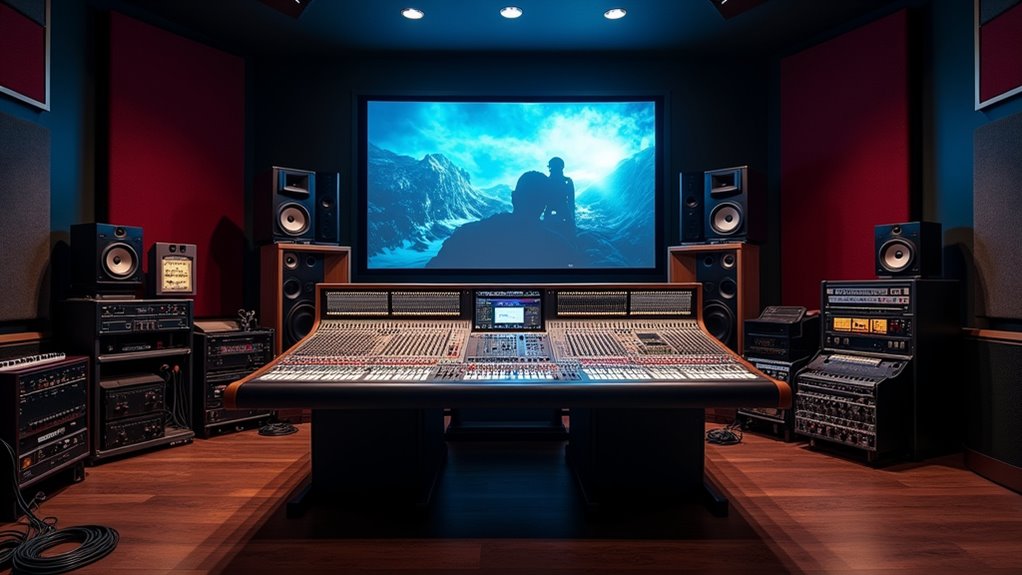Modern cinematic techniques orchestrate powerful emotional responses through deliberate manipulation of camera angles, lighting, and sound design. High angles diminish characters while low angles convey authority, with Dutch angles creating psychological unease. Chiaroscuro lighting and strategic shadows craft visual metaphors, while immersive sound mixing and spatial audio technologies like Dolby Atmos heighten viewer engagement. These technical elements blend seamlessly to transform ordinary scenes into rich storytelling tapestries that reward closer examination of their intricate layers.
The Psychology Behind Camera Angles and Movement

Filmmakers choose to position and move their cameras in ways that can profoundly shape the psychological experience of viewing a film. Each camera angle serves as a deliberate tool in the director’s arsenal, manipulating viewers’ emotions with surgical precision. High angles diminish characters, making villains seem suddenly vulnerable or heroes appear overwhelmed, while low angles transform ordinary characters into towering figures of authority. The careful selection of camera angles creates essential visual narratives that guide audience interpretation. These visual elements help create a sensory experience that deeply resonates with viewers on an emotional level.
The way cameras move through scenes adds another layer of psychological complexity. Steady, smooth dolly shots create a sense of control and certainty, while handheld movements can throw viewers into chaos, making them feel like unwitting participants in the action. Shows like Succession demonstrate how unstable camera work heightens tension.
Modern directors often play with these established techniques, combining classical Hitchcockian angles with contemporary innovations. The Dutch angle, that tilted perspective popularized by German Expressionists, still manages to unsettle audiences today, proving that some psychological triggers in cinematography remain timeless, even as technology evolves.
Light and Shadow: Creating Emotional Landscapes
In the shadowy realm of cinematography, light and darkness dance an eternal waltz that transforms ordinary scenes into powerful emotional landscapes. Cinematographers wield these elements like master painters, using techniques such as chiaroscuro and strategic shadow placement to craft visual stories that resonate deep within viewers’ psyche. Wrap around lighting creates natural transitions between illuminated and shadowed areas on subjects’ faces, enhancing the realism of each frame.
Through the deliberate manipulation of hard and soft light sources, filmmakers create depth and dimension that guide audience attention while establishing mood. A character stepping from shadow into warm light might symbolize hope, while harsh overhead lighting can transform a friendly face into something sinister. Low-key lighting intensifies the psychological horror experience in frightening scenes. Just as sound design shapes a scene’s emotional impact, the careful orchestration of light elements guides viewers through the story’s emotional journey.
The clever use of gobos and dynamic lighting angles adds layers of visual metaphor, turning simple scenes into complex emotional tapestries. This interplay between light and shadow does more than just illuminate; it speaks directly to viewers’ subconscious, creating an immersive atmosphere that enhances narrative impact and deepens emotional engagement with the story being told.
Weaving Sound and Visuals for Maximum Impact

Sound and visuals collide in a mesmerizing dance that elevates cinematic storytelling beyond its individual components. Through advanced mixing techniques like object-based audio and wave field synthesis, filmmakers craft immersive experiences that transport viewers into their carefully constructed worlds.
The strategic interplay of silence and sound, coupled with precise visual synchronization, builds tension in ways that mere dialogue never could. Modern sound designers leverage everything from field recordings to procedural audio generation, creating rich soundscapes that breathe life into every frame. Foley artists recreate everyday sounds with unconventional props to build authentic, dynamic scenes. Atmospheric elements help establish believable environments that ground viewers in the story’s reality.
When combined with spatial audio technologies like Dolby Atmos, these techniques deliver an almost tactile viewing experience. The marriage of authentic ambient sounds with emotionally resonant musical scores doesn’t just complement the visuals – it transforms them. The horizontal film format used in IMAX theaters creates images over eight times larger than standard film, delivering unprecedented visual clarity and immersion.
Whether it’s the spine-tingling crescendo in a horror scene or the deliberate absence of sound in a dramatic moment, sound design has evolved into an art form that’s equally crucial as cinematography in shaping the audience’s journey.
Frequently Asked Questions
How Do Modern Digital Effects Influence Traditional Cinematography Techniques?
Modern digital effects have transformed traditional cinematography by seamlessly blending practical and virtual elements, allowing cinematographers to push creative boundaries while maintaining classical techniques.
While traditional lighting, framing, and camera movements remain essential, digital tools enhance these fundamentals through advanced color grading, virtual sets, and real-time previsualization.
This marriage of old and new creates unprecedented visual possibilities, though some purists argue it diminishes the craft’s organic nature.
What Role Does Aspect Ratio Selection Play in Storytelling?
Aspect ratio selection serves as a powerful narrative tool, shaping how audiences experience and interpret a story.
From the claustrophobic intensity of horror films using tighter frames to the sweeping grandeur of widescreen epics, these compositional choices directly influence emotional impact.
Directors strategically employ different ratios to establish time periods, highlight character perspectives, and create distinct visual languages that enhance their storytelling, much like how The Grand Budapest Hotel uses aspect ratios to differentiate between timelines.
How Do Cultural Differences Affect the Interpretation of Cinematic Techniques?
Cultural differences significantly influence how audiences interpret cinematic techniques, from pacing preferences to symbolic meanings.
While fast-cutting might energize Western viewers, Asian audiences often appreciate longer, contemplative shots that mirror their storytelling traditions.
Similarly, color symbolism varies dramatically – white represents death in some Eastern cultures but purity in Western contexts, fundamentally altering how audiences process visual storytelling techniques and emotional cues.
Which Cinematic Techniques Work Best for Social Media and Mobile Viewing?
Social media-optimized cinematic techniques prioritize vertical framing, quick cuts, and eye-catching opening shots that grab attention within seconds.
Close-ups and medium shots work particularly well on small screens, while dramatic lighting creates scroll-stopping contrast.
Short tracking movements, seamless transitions, and punchy sound design keep mobile viewers engaged, making complex narratives digestible through snackable segments that maintain high production value despite platform constraints.
How Do Budget Constraints Affect Choices in Cinematography and Production Methods?
Budget constraints fundamentally shape cinematographic decisions, forcing filmmakers to embrace creative workarounds and practical effects over expensive CGI.
Directors often opt for handheld cameras, natural lighting, and accessible locations to maintain visual quality while cutting costs.
Limited resources can actually spark innovation, as seen in films like “Blair Witch Project” where budget limitations birthed an entirely new found-footage genre, proving that financial restrictions sometimes lead to groundbreaking techniques.
